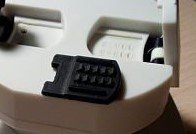Page 1 of 1
Make hole in adapter rubber
Posted: Wed Sep 18, 2019 6:35 pm
by ivangallego24
I was thinking of making a hole in the rubber of the adapter if I finally solve the phone's power button, my question is how can I make the hole?
Re: Make hole in adapter rubber
Posted: Wed Sep 18, 2019 7:14 pm
by 75RR
I was thinking of making a hole in the rubber of the adapter if I finally solve the phone's power button, my question is how can I make the hole?
It would help if you could include a photo that showed what the problem was. This would hopefully reveal what kind of rubber was involved as well as its thickness.
Re: Make hole in adapter rubber
Posted: Wed Sep 18, 2019 9:39 pm
by Hobbyst46
A hollow tube, made of brass or steel, and whose rim is shaped as a circular blade, is appropriate to cut out holes in rubber. It is also called a "cork borer". Round hole punches are appropriate, especially if the rubber layer is thin. In principle, it is possible to bore the hole by moistening the rubber with a little glycerine and slowly turning the punch, forcibly against the rubber. I punch out holes with a punch and hammer, keeping the rubber layer flat on top of a plate of wood.
If the rubber is part of the phone or adapter, though, I would not rush with the hammer...
Re: Make hole in adapter rubber
Posted: Wed Sep 18, 2019 9:59 pm
by ivangallego24

- IMG_20190909_222734_opt (2).jpg (27.98 KiB) Viewed 4351 times
Re: Make hole in adapter rubber
Posted: Wed Sep 18, 2019 10:08 pm
by Hobbyst46
There are narrow-bore punches on eBay, for a few $$ apiece. Alternatively, if you find a rigid thin-wall tube of the proper diameter, and sharpen one end of it on a grinder or emery-cloth, so it becomes a borer. Then apply turning under mild pressure as suggested above. It requires some patience though.
Re: Make hole in adapter rubber
Posted: Thu Sep 19, 2019 7:39 am
by MicroBob
Some badminton rackets have a main tube made of hardened high carbon steel. They give excellent hole punches when ground without heating above 200 °C.
For the wood block end grain is much better than transversal grain.
Bob